OWC Mercury Electra 3G MAX 960GB Review: 1TB of NAND in 2.5" Form Factor
by Kristian Vättö on October 18, 2012 1:00 AM ESTAnandTech Storage Bench 2011
Last year we introduced our AnandTech Storage Bench, a suite of benchmarks that took traces of real OS/application usage and played them back in a repeatable manner. Anand assembled the traces out of frustration with the majority of what we have today in terms of SSD benchmarks.
Although the AnandTech Storage Bench tests did a good job of characterizing SSD performance, they weren't stressful enough. All of the tests performed less than 10GB of reads/writes and typically involved only 4GB of writes specifically. That's not even enough exceed the spare area on most SSDs. Most canned SSD benchmarks don't even come close to writing a single gigabyte of data, but that doesn't mean that simply writing 4GB is acceptable.
Originally we kept the benchmarks short enough that they wouldn't be a burden to run (~30 minutes) but long enough that they were representative of what a power user might do with their system. Later, however, we created what we refer to as the Mother of All SSD Benchmarks (MOASB). Rather than only writing 4GB of data to the drive, this benchmark writes 106.32GB. This represents the load you'd put on a drive after nearly two weeks of constant usage. And it takes a long time to run.
1) The MOASB, officially called AnandTech Storage Bench 2011—Heavy Workload, mainly focuses on the times when your I/O activity is the highest. There is a lot of downloading and application installing that happens during the course of this test. Our thinking was that it's during application installs, file copies, downloading, and multitasking with all of this that you can really notice performance differences between drives.
2) We tried to cover as many bases as possible with the software incorporated into this test. There's a lot of photo editing in Photoshop, HTML editing in Dreamweaver, web browsing, game playing/level loading (Starcraft II and WoW are both a part of the test), as well as general use stuff (application installing, virus scanning). We included a large amount of email downloading, document creation, and editing as well. To top it all off we even use Visual Studio 2008 to build Chromium during the test.
The test has 2,168,893 read operations and 1,783,447 write operations. The IO breakdown is as follows:
| AnandTech Storage Bench 2011—Heavy Workload IO Breakdown | ||||
| IO Size | % of Total | |||
| 4KB | 28% | |||
| 16KB | 10% | |||
| 32KB | 10% | |||
| 64KB | 4% | |||
Only 42% of all operations are sequential; the rest ranges from pseudo to fully random (with most falling in the pseudo-random category). Average queue depth is 4.625 IOs, with 59% of operations taking place in an IO queue of 1.
Many of you have asked for a better way to really characterize performance. Simply looking at IOPS doesn't really say much. As a result we're going to be presenting Storage Bench 2011 data in a slightly different way. We'll have performance represented as Average MB/s, with higher numbers being better. At the same time we'll be reporting how long the SSD was busy while running this test. These disk busy graphs will show you exactly how much time was shaved off by using a faster drive vs. a slower one during the course of this test. Finally, we will also break out performance into reads, writes, and combined. The reason we do this is to help balance out the fact that this test is unusually write intensive, which can often hide the benefits of a drive with good read performance.
There's also a new light workload for 2011. This is a far more reasonable, typical every day use case benchmark. It has lots of web browsing, photo editing (but with a greater focus on photo consumption), video playback, as well as some application installs and gaming. This test isn't nearly as write intensive as the MOASB but it's still multiple times more write intensive than what we were running last year.
We don't believe that these two benchmarks alone are enough to characterize the performance of a drive, but hopefully along with the rest of our tests they will help provide a better idea. The testbed for Storage Bench 2011 has changed as well. We're now using a Sandy Bridge platform with full 6Gbps support for these tests.
AnandTech Storage Bench 2011—Heavy Workload
We'll start out by looking at average data rate throughout our new heavy workload test:
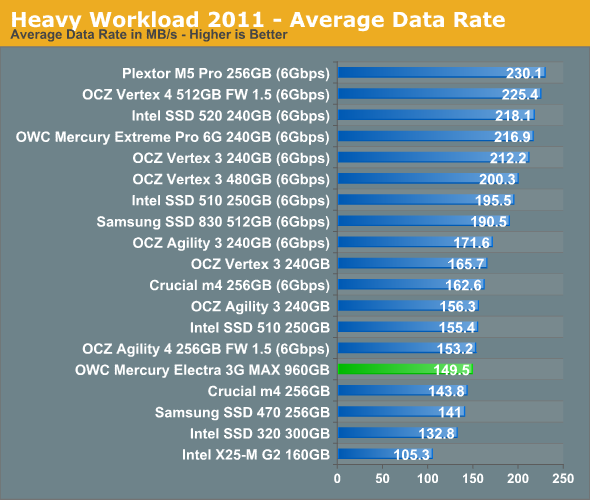
While the random performance of Mercury Electra wasn't great, it does surprisingly well in our Heavy suite. It's a bit slower than SF-2281 drives at SATA 3Gbps but it beats for example Intel's SSD 320.
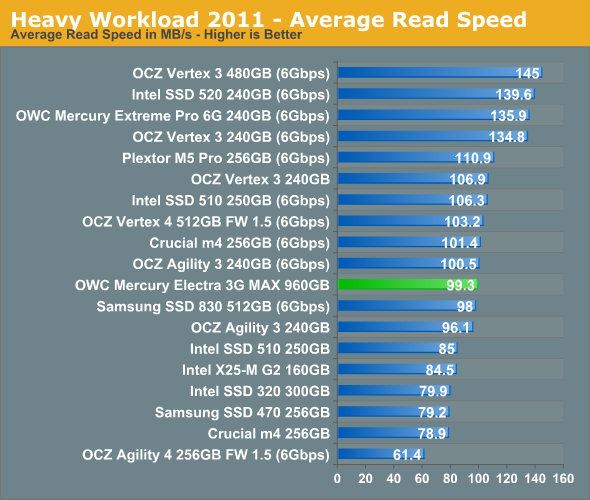

The next three charts just represent the same data, but in a different manner. Instead of looking at average data rate, we're looking at how long the disk was busy for during this entire test. Note that disk busy time excludes any and all idles; this is just how long the SSD was busy doing something:
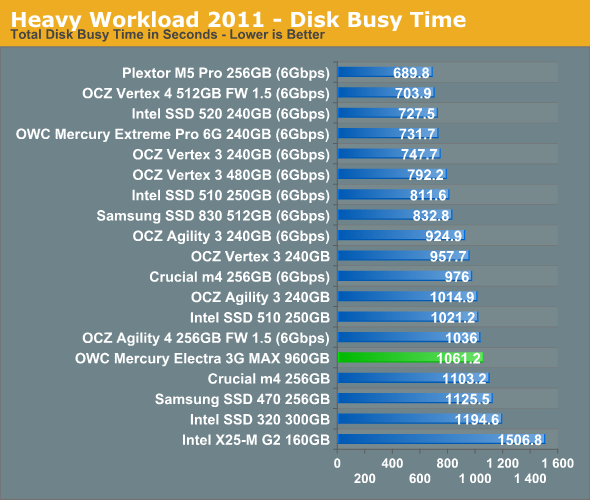
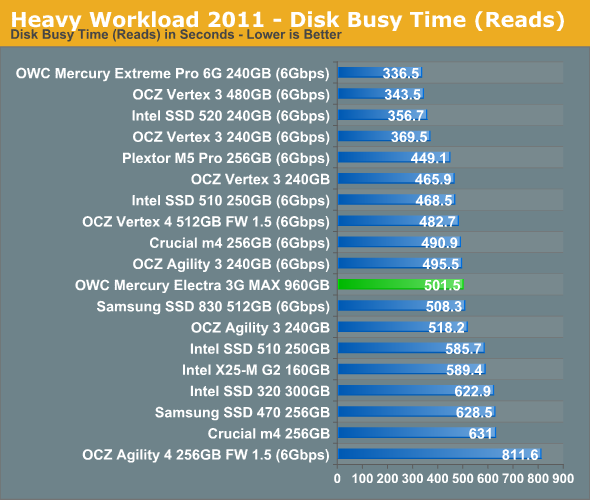
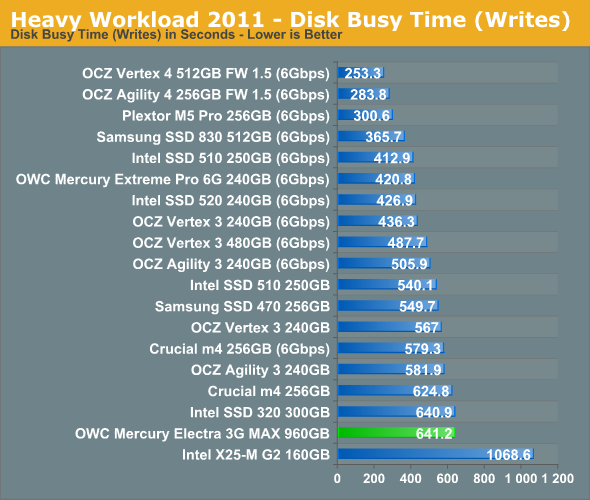










36 Comments
View All Comments
cyrusfox - Thursday, October 18, 2012 - link
I sort of get it, this thing is kind of affordable but in a year, with next gen Nand available128Gb/16GB), all prices will continue to crash($/gb). And high storage nand in 2.5" form factor is not all that unique. OCZ has had a 1tb drive out since at least may (OCT1-25SAT3-1T), which can be found on newegg or amazon. When you are already spending more than a grand for a drive, might as well grab one that is at least 6 Gbps compatible.Either drive will depreciate faster than is acceptable for me. I am still waiting for a $130 fire sale on an Vertez 4 256gb though, right now I have a poor mans raid 0 of a 128gb vertex 4 and a 120gb Agility 3, both of which I paid $140 plus for awhile ago. Its just as bad as when I spent $100 for 4gb of DDR3 3yrs ago. Buyers remorse, the cost of adopting tech early.
SpaceRanger - Thursday, October 18, 2012 - link
If this thing is for Audio and Video Professionals, then it's more than likely targeted for Mac users. Mac users are well known for overpaying for their hardware, so the price for this piece of steaming pile is fitting.ajp_anton - Thursday, October 18, 2012 - link
You really need to fix your chart making when performance is very low.If the performance number doesn't fit the bar, move it next to it instead of overlapping with the product name.
I commented on this years ago but nothing's happened. We don't often see the bars go so low, but sometimes they do.
Kristian Vättö - Thursday, October 18, 2012 - link
Our CMS makes the graphs automatically so I can't play with small details like where the actual number is placed. I'll pass a word to Anand and see if there is a way to fix it, because I find that irritating as well.JarredWalton - Thursday, October 18, 2012 - link
Actually, there is a way to do this Kristian: check the "outer labels" box at the top-right of the graph. I've fixed the two random write charts and regenerated.ajp_anton - Thursday, October 18, 2012 - link
Thanks, hopefully all of you remember to do this when necessary (looks like it requires manual work).For consistency between different charts, you should either make this the default, or change it so it only places them outside for too small values. Maybe even for all values below 50% of the largest.
Juddog - Thursday, October 18, 2012 - link
I don't buy that they couldn't afford to put a SATA6G connection on there. The price is already through the roof and newer SSD's hit way past the normal limits of SATA3G (some even bump up against the SATA6G limit).Kristian Vättö - Thursday, October 18, 2012 - link
OWC didn't exactly specify why they had to stick with SATA 3Gbps, they only said it was a combination of things including price, thermals and space. I wouldn't be surprised if there simply was no SATA 6Gbps controller as the market for such controllers is fairly small. I know Silicon Image doesn't have one, at least.dave_the_nerd - Thursday, October 18, 2012 - link
I have a Macbook with an HDD + SSD in an optical bay adapter, but I'd sooner duct tape an external drive to the back of the lid that overspend on something like this.Hell, I'd rather install a pair of WD Blacks and software RAID them.
Audio doesn't need as much sequential I/O as video, though, I guess.
Somebody will buy it though.
JonBendtsen - Thursday, October 18, 2012 - link
What if they used JBOD or linear raid rather than raid0?